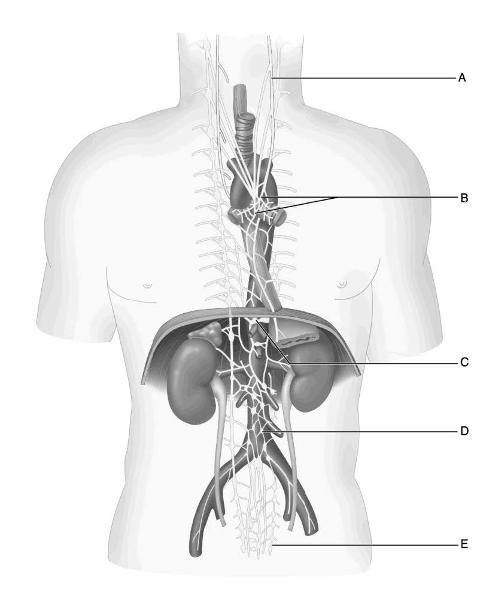
Which letter indicates the celiac ganglion and plexus?
A)
A
B) B
C) C
D) D
E) E
C
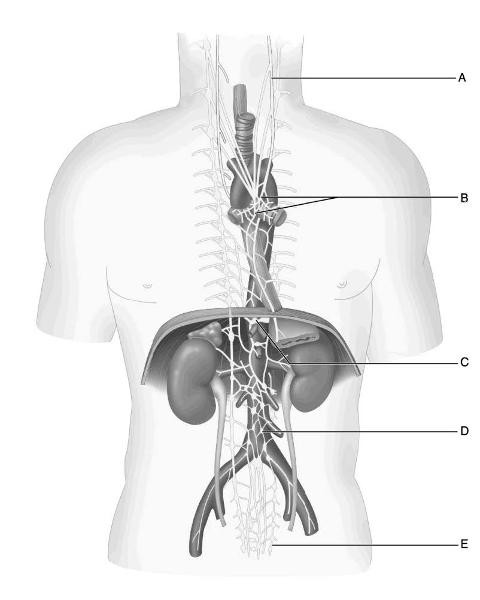
Which letter indicates the aortic plexus?
A) A
B) B
C)
C
D) D
E) E
D
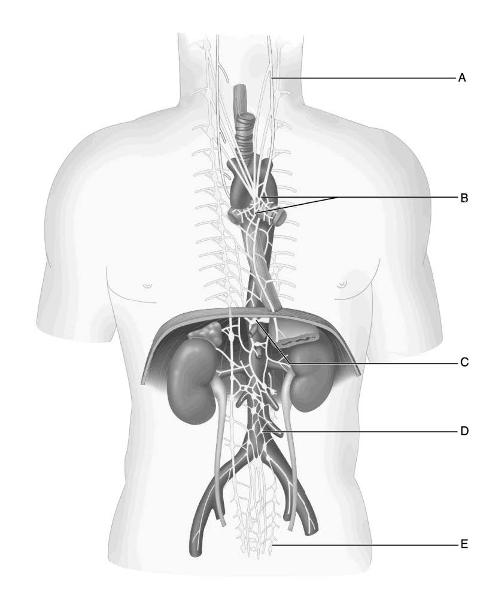
Which letter indicates the left vagus nerve?
A) A
B)
B
C) C
D) D
E) E
A
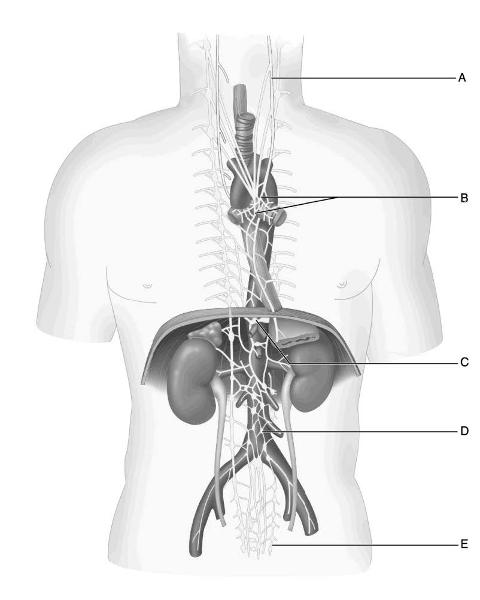
Which letter indicates the cardiac plexus?
A) A
B)
B
C) C
D) D
E) E
B
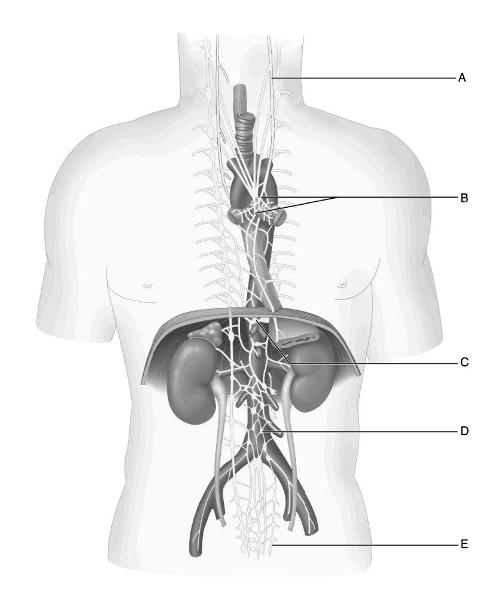
Which letter indicates the pelvic sympathetic trunk?
A)
A
B) B
C) C
D) D
E) E
E
The general visceral motor division of the peripheral nervous system
describes the
A) parasympathetic division.
B) sympathetic
division.
C) autonomic nervous system.
C
Division of the ANS responsible for the fight-or-flight response
describes the
A) parasympathetic division.
B) sympathetic
division.
C) autonomic nervous system.
B
Division of the ANS most active during vigorous exercise describes
the
A) parasympathetic division.
B) sympathetic
division.
C) autonomic nervous system.
B
Division of the ANS most active when the body is at rest describes
the
A) parasympathetic division.
B) sympathetic
division.
C) autonomic nervous system.
A
This division can also be called the craniosacral division.
A)
parasympathetic division
B) sympathetic division
C)
autonomic nervous system
A
Cell body of this autonomic neuron lies outside the CNS.
A)
collateral ganglia
B) rami communicantes
C) pre-ganglionic
neuron
D) splanchnic nerves
E) post-ganglionic neuron
E
Cell body of this autonomic neuron lies within the CNS.
A)
collateral ganglia
B) rami communicantes
C) pre-ganglionic
neuron
D) splanchnic nerves
E) post-ganglionic neuron
C
Division that is dominant during exercise, excitement, or
emergencies.
A) parasympathetic
B) enteric nervous
system
C) inferior hypogastric plexus
D) sympathetic
E) cholinergic
D
The overall integrating center for the ANS.
A)
hypothalamus
B) medulla
C) medulla oblongata
D) rami
communicantes
E) sympathetic trunk
A
Division that is dominant during rest, digestion, and
excretion.
A) parasympathetic
B) enteric nervous
system
C) inferior hypogastric plexus
D) sympathetic
E) cholinergic
A
A descriptive term that identifies the type of neurotransmitter
released by sympathetic
postganglionic fibers.
A)
postganglionic neuron
B) adrenergic
C) medulla
D)
cholinergic
E) none of the above
B
A class of preganglionic fibers present in both sympathetic and
parasympathetic divisions.
A) postganglionic neuron
B)
adrenergic
C) medulla
D) cholinergic
E) none of the above
D
Short nerve branches that connect the ventral rami of spinal nerves
to the sympathetic
ganglia.
A) hypothalamus
B)
medulla
C) medulla oblongata
D) rami communicantes
E)
sympathetic trunk
D
Sympathetic structures of the abdomen that lie anterior to the
vertebral column.
A) collateral ganglia
B) rami
communicantes
C) pre-ganglionic neuron
D)
hypothalamus
E) medulla oblongata
A
Adrenergic hormones are secreted into the bloodstream in this region
of the adrenal gland.
A) hypothalamus
B) medulla
C)
medulla oblongata
D) rami communicantes
E) sympathetic trunk
B
Three-neuron reflex arcs that exist entirely within the walls of the
digestive tract.
A) parasympathetic
B) enteric nervous
system
C) inferior hypogastric plexus
D) sympathetic
E) cholinergic
B
Location in the brain of the cardiorespiratory and vasomotor control
centers.
A) hypothalamus
B) medulla
C) medulla
oblongata
D) rami communicantes
E) sympathetic trunk
C
Ganglia of this structure are connected to the ventral rami of spinal
nerves through the rami
communicantes.
A) collateral
ganglia
B) sympathetic trunk
C) pre-vertebral
ganglia
D) inferior hypogastric plexus
E) celiac ganglion
B
Network of autonomic axons giving rise to nerves of the pelvic
organs.
A) aortic plexus
B) pulmonary plexus
C)
inferior hypogastric plexus
D) stellate ganglion
E) dorsal
root ganglion
C
Sacral nerves carrying parasympathetic innervation to the pelvic
organs.
A) pelvic splanchnic nerves
B) sacral splanchnic
nerves
C) thoracic splanchnic nerves
D) vagus nerve
E)
enteric nervous system
A
The defecation and urination reflexes are integrated in the
A)
brain stem.
B) cerebral cortex.
C) hypothalamus.
D)
spinal cord.
D
Which of these is not innervated by the ANS?
A) cardiac
muscle
B) smooth muscle
C) skeletal muscle
D) glands
C
Which division of the autonomic nervous system innervates the sweat
glands in skin?
A) sympathetic
B) parasympathetic
C)
somatic
D) integumentary
A
Which division of the autonomic nervous system has preganglionic
fibers within the facial
nerve?
A) sympathetic
B)
parasympathetic
C) somatic
D) CNS
B
Another name for the ANS is the
A) general visceral motor
system.
B) general somatic motor system.
C) branchial motor
system.
D) general peripheral nervous system.
A
Focusing the eye on a nearby object in the field of vision is a
function of which division of
the ANS?
A)
sympathetic
B) parasympathetic
C) somatic
D) cranial
B
Which division of the nervous system is characterized by highly
branched postganglionic
fibers that innervate multiple
organs?
A) parasympathetic
B) somatic motor
C)
sympathetic
D) visceral sensory
C
The gray and white rami communicantes attach to the
A) dorsal
root ganglia.
B) ventral rami.
C) dorsal roots.
D)
spinal nerves.
B
All of the following have only sympathetic innervation except
the
A) blood vessels.
B) sweat glands.
C) arrector
pili.
D) salivary glands.
D
Which of the following cranial nerves does not supply parasympathetic
fibers to the head?
A) oculomotor
B) facial
C)
vagus
D) glossopharyngeal
C
Which of these statements concerning the glossopharyngeal nerve is
incorrect?
A) The preganglionic fibers originate in the inferior
salivatory nucleus.
B) The pre- and postganglionic fibers travel
in this nerve.
C) The pre- and postganglionic fibers synapse in
the otic ganglion.
D) Stimulation induces secretion from the
parotid gland.
B
Which of these characteristics definitively distinguishes the
autonomic nervous system from
the somatic nervous system?
A)
cell bodies outside the CNS
B) cell bodies within the CNS
C)
cholinergic fibers
D) myelinated axons
A
Which of these is not a characteristic of the parasympathetic
division?
A) branched fibers
B) cholinergic fibers
C)
intramural ganglia
D) myelinated fibers
A
Only about half a dozen parasympathetic ganglia have specific names.
Two of these are the
A) celiac and superior mesenteric.
B)
inferior and superior hypogastric.
C) ciliary and
pterygopalatine.
D) chain and prevertebral.
C
What stimulates the adrenal medulla to secrete its excitatory
neurohormones?
A) postganglionic sympathetic neurons
B)
preganglionic sympathetic neurons
C) preganglionic
parasympathetic neurons
D) postganglionic parasympathetic neurons
B
All of the following plexi contain fibers from the vagus nerve
except
A) the otic.
B) the esophageal.
C) the
celiac.
D) the superior mesenteric.
A
The parasympathetic nervous system is characterized by
A)
peripheral ganglia near the organs, and short postganglionic
fibers.
B) peripheral ganglia near the organs, and long
postganglionic fibers.
C) peripheral ganglia near the spinal
cord, and short postganglionic fibers.
D) peripheral ganglia near
the spinal cord, and long postganglionic fibers.
A
Which of these statements concerning the sympathetic division is
incorrect?
A) The preganglionic cell bodies form the lateral gray
horn in some areas of the spinal cord.
B) There is a sympathetic
trunk ganglion for each of the 31 spinal nerves.
C) There is
approximately one chain ganglion for each spinal nerve.
D) It is
more complex than the parasympathetic system because it supplies more
structures than
the parasympathetic system.
B
Which of these statements is not a characteristic of collateral
ganglia of the sympathetic
division?
A) They lie in the
abdomen and pelvis.
B) They are paired and segmented.
C)
They lie anterior to the vertebral column.
D) They are located
mostly on the abdominal aorta.
B
The sympathetic system causes
A) decreased blood glucose and
peristalsis, and increased heart rate and blood pressure.
B)
increased blood glucose and peristalsis, and decreased heart rate and
blood pressure.
C) increased blood glucose, heart rate, and blood
pressure, and decreased peristalsis.
D) decreased blood glucose,
heart rate, and blood pressure, and increased peristalsis.
C
Which of these statements concerning gray rami communicantes is
incorrect?
A) They carry postganglionic fibers to peripheral
structures.
B) Their fibers are unmyelinated.
C) They
contain all the preganglionic fibers traveling to the sympathetic
chain.
D) They are associated with sympathetic trunk ganglia.
C
Which of these descriptions is not a result of parasympathetic
stimulation?
A) production of goose bumps
B) constriction of
the pupils
C) increased peristalsis of the digestive
viscera
D) contraction of the bladder wall in urination
A
The site of origin of the preganglionic fibers of the parasympathetic
nervous system is the
A) thoracolumbar region of the spinal
cord.
B) higher brain centers.
C) chain and prevertebral
ganglia.
D) brain stem and the sacral region of the cord.
D
Cranial parasympathetic outflow is contained in all of the following
cranial nerves except the
A) accessory.
B) facial.
C)
glossopharyngeal.
D) vagus.
A
The micturition (urination) reflex is controlled by a parasympathetic
reflex pathway in which
A) the preganglionic neurons are in the
dorsal motor nucleus of the vagus in the brain.
B) the
preganglionic cell bodies are in the wall of the bladder.
C) the
preganglionic axons occur in pelvic splanchnic nerves.
D) the
postganglionic axons occur in the celiac plexus.
C
The trunk ganglia contain what kind of cell bodies?
A)
preganglionic parasympathetic
B) postganglionic
parasympathetic
C) preganglionic sympathetic
D)
postganglionic sympathetic
D
Cell bodies of the preganglionic sympathetic neurons are located
within the
A) dorsal root ganglia.
B) intramural
ganglia.
C) lateral gray horns of the spinal cord.
D)
sympathetic trunk.
C
Which of the following autonomic plexi does not lie on the aorta or
on the main branches of
the aorta?
A) celiac
B)
superior mesenteric
C) inferior mesenteric
D) inferior hypogastric
D
Which autonomic division increases heart rate?
A)
sympathetic
B) parasympathetic
C) somatic
D) cranial
A
In which autonomic division do nerve cell bodies lie closest to the
organs being innervated?
A) sympathetic
B)
parasympathetic
C) visceral sensory
D) somatic motor
B
Postganglionic neurons in the pterygopalatine ganglion
A) are
very active when you cry.
B) are adrenergic.
C) run from the
head to the abdomen.
D) are primarily sympathetic fibers.
A
Parasympathetic postganglionic fibers of the head travel within
the
A) accessory nerve.
B) facial nerve.
C) trigeminal
nerve.
D) vestibulocochlear nerve.
C
Parasympathetic ganglia that are located within the walls of the
innervated organs are called
A) collateral ganglia.
B)
dorsal root ganglia.
C) intramural ganglia.
D) paravertebral ganglia.
C
The part of the brain that exerts more control over autonomic
functioning than any other part
is the
A)
hypothalamus.
B) thalamus.
C) cerebral cortex.
D) cerebellum.
A
Parasympathetic impulses to the stomach pass through the
A)
celiac plexus.
B) esophageal plexus.
C) inferior hypogastric
plexus.
D) superior mesenteric plexus.
B
The adrenal medulla is stimulated by preganglionic neurons localized
to gray matter of the
spinal cord
A) in the cervical
region.
B) in the upper thoracic region.
C) in the lower
thoracic region.
D) in the lower lumbar region.
C
Cell bodies of preganglionic sympathetic neurons are located within
the
A) dorsal root ganglia.
B) intramural ganglia.
C)
lateral horns of the gray matter of the spinal cord.
D)
sympathetic trunk.
C
The cell bodies of postganglionic neurons that stimulate secretion of
the parotid gland are in
the
A) superior cervical
ganglion.
B) submandibular ganglion.
C) otic
ganglion.
D) sphenopalatine ganglion.
C
Which one of these is solely innervated by the parasympathetic
division?
A) adipose tissue
B) arrector pili muscle of the
hair follicle
C) ciliary muscle of the eye
D) sweat glands
C
Identify the pathway that correctly traces the movement of
preganglionic sympathetic fibers.
A) dorsal root to gray ramus
communicans to sympathetic trunk ganglion
B) dorsal root to
sympathetic trunk ganglion to gray ramus communicans
C) ventral
root to sympathetic trunk ganglion to white ramus communicans
D)
ventral root to white ramus communicans to sympathetic trunk ganglion
D
Another name for a chain ganglion is
A) sympathetic
trunk.
B) paravertebral ganglion.
C) prevertebral
ganglion.
D) intramural ganglion.
B
The ANS stimulates cardiac muscle as well as smooth muscle and
glands. Which of the
following nerves carries autonomic fibers
that increase the rate of cardiac muscle contraction?
A) phrenic
nerves
B) sympathetic nerves from the lower half of the
thoracolumbar spinal cord
C) vagus nerves
D) sympathetic
nerves from the middle and inferior cervical ganglion
D
The secretions of the adrenal medulla act to supplement the effects
of
A) parasympathetic innervation.
B) sympathetic
stimulation.
C) vagus nerve activity.
D) reflex control.
B
Sympathetic fibers leave the spinal cord in the
A) craniosacral
regions, and the postganglionic fibers secrete norepinephrine.
B)
thoracolumbar region, and the postganglionic fibers secrete
acetylcholine.
C) craniosacral regions, and the postganglionic
fibers secrete acetylcholine.
D) thoracolumbar region, and the
postganglionic fibers secrete norepinephrine.
D
Where would you not find an autonomic ganglion?
A) in the
head
B) in the cervical region
C) in the armpit
D)
alongside the vertebral column
C
Cardiovascular effects of the sympathetic division include all of the
following except
A) constriction of most blood vessels.
B)
dilation of the vessels serving the skeletal muscles.
C) increase
in heart rate and force.
D) dilation of the blood vessels serving
the skin and digestive viscera.
D
Over 90% of all preganglionic parasympathetic fibers are in cranial
nerve
A) III.
B) V.
C) VII.
D) X.
D
Control of temperature, of autonomic nervous reflexes, of hunger, and
of sleep are functions
associated with the
A)
medulla.
B) cerebellum.
C) hypothalamus.
D) thalamus.
C
This organ contains modified sympathetic postganglionic neurons that
lack nerve processes.
A) adrenal medulla
B) collateral
ganglia
C) stellate ganglion
D) sympathetic chain ganglia
A
Visceral pain results from all the following except
A) cutting
of an organ.
B) chemical irritation of an organ.
C)
excessive stretch of an organ.
D) inflammation of an organ.
A
What is the effect of parasympathetic stimulation of respiratory
bronchioles in the lungs?
A) constriction
B)
dilation
C) decreased secretion of mucus
D) no effect
A
Which of the following disorders of the sympathetic division does not
involve a problem
with blood vessels?
A) mass reflex
reaction
B) congenital megacolon
C) Raynaud's
disease
D) hypertension
B
Preganglionic fibers are myelinated, whereas postganglionic fibers are unmyelinated.
A) True
B) False
A
Parasympathetic stimulation of blood vessels causes vasoconstriction
and increased blood
pressure.
A) True
B) False
B
Fibers from the cranial and sacral regions of the spinal cord contribute to the sympathetic division.
A) True
B) False
B
Postganglionic sympathetic fibers are relatively long compared to those of the parasympathetic division.
A) True
B) False
A
The sympathetic and parasympathetic divisions can be distinguished by the amount of branching of the post-ganglionic fibers.
A) True
B) False
A
Postganglionic sympathetic fibers release norepinephrine and are called cholinergic fibers.
A) True
B) False
B
Adrenergic postganglionic neurons release the hormones norepinephrine and epinephrine.
A) True
B) False
A
All parasympathetic postganglionic fibers of the head travel through the trigeminal nerve (V) to their final destinations.
A) True
B) False
A
The cardiac center of the medulla oblongata regulates the diameter of blood vessels.
A) True
B) False
B
Vagal stimulation of the heart decreases heart rate, resulting in a drop in blood pressure.
A) True
B) False
A
Sympathetic trunk ganglia contain the cell bodies of sensory neurons and are located in the dorsal root of the spinal cord.
A) True
B) False
B
The main integration center of the ANS is the amygdala.
A) True
B) False
B
Because the fibers of the sympathetic division arise from the thoracic and lumbar regions of the spinal cord, they cannot innervate structures of the head or pelvis.
A) True
B) False
B
Parasympathetic stimulation of the pelvic organs cause defecation, voiding of urine, and erection.
A) True
B) False
A
Parasympathetic fibers innervate the sweat glands, arrector pili, and smooth muscles of the arteries.
A) True
B) False
B